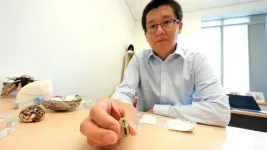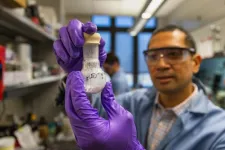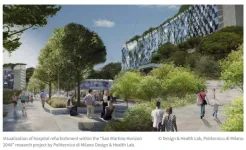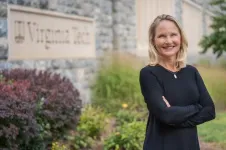(Press-News.org) Ling Li, associate professor in the Department of Mechanical Engineering, has been awarded $1.05 million over three years to lead a team studying the visual abilities of a unique underwater creature with thousands of eyes.
The project reunites Li with a former collaborator, University of South Carolina Associate Professor Daniel Speiser. They also enlisted the expertise of an internationally recognized applied mathematician who specializes in image processing, Daniel Baum of the Zuse Institute in Berlin.
What stony eyes see and what it means
The team’s research will focus on the stony eyes of chitons. These marine creatures have pill-shaped, hard outer shells with overlapping plates and soft inner bodies. Their shells are made of a calcium carbonate material called aragonite, one of the primary ingredients from which pearls are formed. To see its surroundings, a chiton uses thousands of tiny, stony eyes embedded in its shell’s armored plates, all formed from the same rugged material.
Speiser made early discoveries of the makeup of a chiton’s optic system, formulating ideas about the creature’s ability to see images. During Li’s Ph.D. studies at the Massachusetts Institute of Technology and subsequent postdoctoral work at Harvard, Li joined Speiser and collaborators to build off Speiser’s initial work and explore how the eyes work. Together, they devised an experimental setup allowing them to look directly through the chiton’s aragonite lens, seeing blurred but recognizable shapes.
Aragonite eyes are rigid and therefore cannot adjust their focus or viewing directions in the way the soft eyes of many creatures can. While Speiser and Li’s early work demonstrated the working principles and corresponding structural basis for single stony eyes, the animal’s ability to process visual information goes beyond individual eyes. These rigid optical elements are interconnected through a complex microscopic channel network that houses photosensitive cells and neural tissues, forming an integrated neural network. The animal gets visual feedback, but each eye isn’t processing much data. Because a single eye is roughly the width of a human hair, single-eye chiton vision is far from high-definition.
Still, a chiton’s shell has hundreds to thousands of those eyes. Do all the tiny images come back together in the chiton’s nervous system? Is it able to take those fragments and form a full picture? Does the visual information acquired from individual eyes reconstitute as a more high-definition image?
Answering new questions with a new team
Li and Speiser sought out funding opportunities to explore these new questions through their research. They secured a grant from the Human Frontier Science program, a booster of frontier, basic research focused on living organisms. The program provides research funding to support innovative research into fundamental biological problems, particularly projects with novel and interdisciplinary approaches that create international partnerships.
Li and Speiser’s project to uncover the working principles of the unique distributed sensing system of chitons was certainly novel.
Li’s team at Virginia Tech has established a storied history in exploring unique material design strategies from nature, having studied sea urchin-inspired ceramics and starfish microlattices. Speiser built a robust portfolio of projects at South Carolina in animal biology and physiology. The additional years of experience built in their respective labs gave them a deeper well of knowledge from which to draw and revisit their chiton questions.
Li and Speiser met Baum through a colleague and found that the German researcher’s background in image analysis and visualization of biological structures was the critical final piece to the puzzle of interpreting and reporting neural network data.
With backing from the Human Frontier Science program, the team wants to know how a simple marine mollusk processes visual feedback from thousands of eyes and how it pieces together those thousands of points of connected data to make decisions about movement and perceiving danger. A few different species of chiton will be studied so that the researchers can compare results.
Li will use his expertise in biological materials and 3D material characterization to obtain high-resolution 3D data of the chitons’ sensory networks. Baum’s team in Germany will then analyze Li’s dataset to establish digital models and formulate hypotheses about network function. Speiser’s team will pick up from there, testing his colleagues’ theories through animal behavioral experiments. Li will weigh back into that process, providing insight on how the hard and soft materials work together. The team will also investigate how factors such as shell and eye regrowth after damage impact the resilience of this distributed sensing network.
Both Speiser and Baum are eager to begin the project because of its vast potential.
"Learning more about the neural processing underlying vision in chitons is very exciting, as are the opportunities to explore how chitons avoid compromising their armor system by incorporating eyes into it and how they mitigate the metabolic costs incurred by a highly distributed network of hundreds to thousands of sensors," said Speiser.
“This a wonderful project with two experts in biological materials and visual biological systems,” said Baum. “I’m very much looking forward to starting it, adding my own expertise in image analysis and visualization to help shed light on the fascinating visual system of chitons.”
END
Ling Li leads team to see through eyes made of stone
If seeing through two eyes gives humans a picture of their world, what kind of worldview do chitons have with thousands of tiny aragonite eyes? This is the question posed by an international team led by Virginia Tech's Li.
2023-06-09
ELSE PRESS RELEASES FROM THIS DATE:
Proof-of-Concept Program funds 12 research projects
2023-06-09
Virginia Tech Intellectual Properties (VTIP) with LINK + LICENSE + LAUNCH’s Proof-of-Concept Program has provided the springboard for faculty to bring their research to market. Over the past four years, the program has funded 24 Virginia Tech research projects.
“We are excited to be able to support a larger group of proof-of-concept projects in this award cycle,” said Mark Mondry who leads LAUNCH. “Several of the Virginia Tech faculty-led projects in this round include collaborations with students, industry partners, and other academic institutions, bringing diverse perspectives to the project ...
Community Design Assistance Center helps create opportunities in rural Virginia
2023-06-09
The rundown facade of the Thomas Deen building in St. Paul, Virginia, belied the once-impressive department store's better days.
The four-story brick building opened its doors to customers in the early 1920s, but over time, the structure was as forgotten as the discarded tires it housed some 100 years later. As Elizabeth Gilboy, the director of the Community Design Assistance Center, an outreach center in Virginia Tech's College of Architecture, Arts, and Design, and the center's team explored the site in fall 2020, they recognized their unique place at the intersection of the building's history and future.
Since ...
WHO recommends Politecnico di Milano guidelines for the design of future hospitals
2023-06-09
Milan, 9 June 2023 - The World Health Organisation presented in Baku (Azerbaijan) the new design recommendations for new hospitals to be built in the European Region, the result of a research partnership with the Politecnico di Milano. The document was prepared by the Design & Health Lab in the Department of Architecture, Construction Engineering and the Built Environment at the Politecnico under the coordination of Professor Stefano Capolongo.
The COVID-19 pandemic highlighted the importance of preparedness for natural and man-made disasters, emergencies and other social crises. The ability to provide continuous ...
3D 'bio-printing' inside hydrogels
2023-06-09
Scientists from the NIHR Great Ormond Street Hospital Biomedical Research Centre (a collaboration between GOSH and UCL), London, and University of Padova, Italy, have shown for the first time how 3D printing can be achieved inside ‘mini-organs’ growing in hydrogels -- controlling their shape, activity, and even forcing tissue to grow into 'moulds.'
This can help teams study cells and organs more accurately, create realistic models of organs and disease, and even better understand how cancer spreads through different tissues.
A particularly promising area of research at the Zayed Centre for Research ...
Scientists make a surprising discovery about magnetic defects in topological insulators
2023-06-09
Scientists from the Department of Energy’s Ames National Laboratory made an intriguing discovery while conducting experiments to characterize magnetism in a material known as a dilute magnetic topological insulator where magnetic defects are introduced. Despite this material’s ferromagnetism, the team discovered strong antiferromagnetic interactions between some pairs of magnetic defects that play a key role in several families of magnetic topological insulators.
Topological insulators (TIs) as their name indicates, ...
Novel ferroelectrics for more efficient microelectronics
2023-06-09
When we communicate with others over wireless networks, information is sent to data centers where it is collected, stored, processed, and distributed. As computational energy usage continues to grow, it is on pace to potentially become the leading source of energy consumption in this century. Memory and logic are physically separated in most modern computers, and therefore the interaction between these two components is very energy intensive in accessing, manipulating, and re-storing data. A team of researchers from Carnegie Mellon University and Penn State University is exploring materials that could possibly lead to the ...
Quantum materials: Electron spin measured for the first time
2023-06-09
An international research team has succeeded for the first time in measuring the electron spin in matter - i.e., the curvature of space in which electrons live and move - within "kagome materials", a new class of quantum materials.
The results obtained - published in Nature Physics - could revolutionise the way quantum materials are studied in the future, opening the door to new developments in quantum technologies, with possible applications in a variety of technological fields, from renewable energy to biomedicine, from electronics to quantum computers.
Success was ...
Seismic Waves tell lithospheric delamination mechanism in south China
2023-06-09
A research team led by Prof. ZHANG Haijiang from the University of Science and Technology of China (USTC) of the Chinese Academy of Sciences, and Prof. HOU Zengqian from Chinese Academy of Geological Sciences, revealed the seismically imaged lithospheric delamination and its controls on the Mesozoic Magmatic Province in South China by using a new joint seismic inversion algorithm. The study was published in Nature Communications.
Based on the latest developed seismic joint inversion algorithm, the researchers made use of the seismic body wave travel time, surface wave dispersion ...
Program for underrepresented undergraduate students in STEM receives NIH funding
2023-06-09
Alexandra Hanlon, director of the Virginia Tech Center for Biostatistics and Health Data Science, was recently awarded a $1.25 million grant from the National Institutes of Health (NIH) for a summer program aimed at promoting and diversifying the field of collaborative biostatistics.
The Collaborative Undergraduate Biostatistics Experience (CUBE), an eight-week summer program geared toward underrepresented undergraduate students, will receive $250,000 per year over the next five years through the NIH Research Education Program.
This R25 award, which is funded in a joint effort ...
USTC enhances fluorescence brightness of single silicon carbide spin color centers
2023-06-09
In a study published online in Nano Letters, the team led by Prof. LI Chuanfeng and Dr. XU Jinshi from the University of Science and Technology of China of the Chinese Academy of Sciences made progress in enhancing the fluorescence of single silicon carbide spin defects. The researchers leveraged surface plasmons to markedly boost the fluorescence brightness of single silicon carbide double vacancy PL6 color centers, leading to an improvement in the efficiency of spin control using the properties of co-planar waveguides. This low-cost method neither calls for complex micro-nano processing ...
LAST 30 PRESS RELEASES:
Injectable breast ‘implant’ offers alternative to traditional surgeries
Neuroscientists devise formulas to measure multilingualism
New prostate cancer trial seeks to reduce toxicity without sacrificing efficacy
Geometry shapes life
A CRISPR screen reveals many previously unrecognized genes required for brain development and a new neurodevelopmental disorder
Hot flush treatment has anti-breast cancer activity, study finds
Securing AI systems against growing cybersecurity threats
Longest observation of an active solar region
Why nail-biting, procrastination and other self-sabotaging behaviors are rooted in survival instincts
Regional variations in mechanical properties of porcine leptomeninges
Artificial empathy in therapy and healthcare: advancements in interpersonal interaction technologies
Why some brains switch gears more efficiently than others
UVA’s Jundong Li wins ICDM’S 2025 Tao Li Award for data mining, machine learning
UVA’s low-power, high-performance computer power player Mircea Stan earns National Academy of Inventors fellowship
Not playing by the rules: USU researcher explores filamentous algae dynamics in rivers
Do our body clocks influence our risk of dementia?
Anthropologists offer new evidence of bipedalism in long-debated fossil discovery
Safer receipt paper from wood
Dosage-sensitive genes suggest no whole-genome duplications in ancestral angiosperm
First ancient human herpesvirus genomes document their deep history with humans
Why Some Bacteria Survive Antibiotics and How to Stop Them - New study reveals that bacteria can survive antibiotic treatment through two fundamentally different “shutdown modes”
UCLA study links scar healing to dangerous placenta condition
CHANGE-seq-BE finds off-target changes in the genome from base editors
The Journal of Nuclear Medicine Ahead-of-Print Tip Sheet: January 2, 2026
Delayed or absent first dose of measles, mumps, and rubella vaccination
Trends in US preterm birth rates by household income and race and ethnicity
Study identifies potential biomarker linked to progression and brain inflammation in multiple sclerosis
Many mothers in Norway do not show up for postnatal check-ups
Researchers want to find out why quick clay is so unstable
Superradiant spins show teamwork at the quantum scale
[Press-News.org] Ling Li leads team to see through eyes made of stoneIf seeing through two eyes gives humans a picture of their world, what kind of worldview do chitons have with thousands of tiny aragonite eyes? This is the question posed by an international team led by Virginia Tech's Li.





